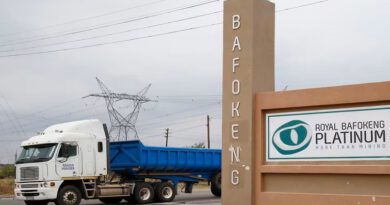Infrastructure spending boost in the budget
The 2021 Budget has provided a boosts to infrastructure spending, with public sector expenditure on infrastructure estimated to increase by 20.6% to R226.1 billion in 2020/21 compared to 2019/20.
Public-sector infrastructure spending over the medium-term expenditure framework (MTEF) period is estimated at R791.2 billion.
State-owned companies continue to be the largest contributor to capital investment, spending a projected R293.7 billion over the next three years.
Provinces are expected to spend R181.9 billion on infrastructure over the same period while municipalities are forecast to spend R190.8 billion and public housing built through the human settlements development grant in provinces expected to total R41.7 billion.
Spending on economic infrastructure, mainly by state-owned companies, accounts for 78.2% of the medium-term estimate.
The Budget Review said these funds are used to expand power-generation capacity, upgrade and expand the transport network, and improve sanitation and water services.
It added that social services infrastructure accounts for 18% of the total, of which health accounts for 5% and education 7%.
Expenditure on economic development rises from R191.9 billion in 2021 to R217.2 billion in 2023/24.
Road infrastructure is the largest spending programme in the economic development function and total expenditure is expected to grow at an average annual growth rate of 8.2% from R86.5 billion in 2020/21 to R109.5 billion in 2023/24.
The Budget Review said this is largely due to underspending on capital expenditure programmes in 2020/21, which is expected to recover over the medium term.
In addition, the review said capital programmes are protected from budget reductions in line with government’s commitment to investing in infrastructure.
To fund new bulk water projects and maintain raw water infrastructure, spending on national water resource management is expected to grow from R28.6 billion in 2020/21 to R30 billion in 2023/24. Planned expenditure over the medium term includes phase 2 of the Lesotho Highlands Water Project and the Mokolo Crocodile Water Augmentation Project.
The review said construction was hard hit by the lockdown regulations, with real value added falling by 20% in the first three quarters of 2020, adding that the outlook remains muted in the context of weak infrastructure investment and continued low confidence.
However, it said the construction sector is expected to grow as government’s initiatives to ramp up capital spending gather pace.
Public Private Partnerships (PPPs) will play a much more important role in infrastructure development, with the review admitting it is evident that government does not have sufficient financial resources to meet the growing infrastructure need.
To help close this gap, the review said government’s economic recovery plan emphasises collaboration with business, labour and civil society and partnering with the private sector, multilateral development banks and development finance institutions to augment its skills, expertise and funding.
“The plan includes immediate measures to boost investor confidence and longer-term reforms to promote sustained economic growth. Higher and more effective infrastructure spending is central to this plan.
“The Infrastructure Fund will play a pivotal role in enhancing collaboration and attracting private-sector investment for infrastructure projects,” it said.
The review said government is providing initial support of R18 billion to the fund over the medium-term expenditure framework (MTEF) period.
The fund has begun work on three projects in student housing, digital infrastructure and water infrastructure but the Budget review warns that fiscal resources are insufficient and bold reforms are needed to lift private-sector investment.
“Confidence and investment remain low. The focus of economic policy, therefore, is to remove structural constraints that obstruct faster growth.
“These constraints include the high cost of doing business in South Africa, low levels of competitiveness and a weak public-sector balance sheet.
“Correcting these problems can unlock large-scale investment by the private sector, which will be the primary source of growth and job creation, with the public sector playing an enabling role,” it said.
The government’s economic recovery plan announced in October 2020 focuses on high-impact reforms, including rolling out infrastructure aligned with the National Development Plan.
This resulted in the announcement in July 2020 of an infrastructure investment project pipeline worth R340 billion in network industries such as energy, water, transport and telecommunications has been developed.
The review said the Infrastructure Fund is preparing investments in student housing, digital communications, and water and sanitation.
A total of 34 PPP project, with a total value of R89.3 billion, have been concluded since this type of partnership was first introduced in South Africa in 1998.
These projects are in the health, transport and roads, and tourism sectors, as well as for head office accommodation.
The review said they have been funded through a combination of equity, debt and, in some instances, government capital contributions.
It said most of these projects are operational, with a few having reached the end of their project term and in some instances project durations have been extended.
The review said the 34 PPPs in operation account for 2% of the total public-sector infrastructure expenditure budget and therefore do not pose significant risks to the fiscus.
“Over the medium term, it is anticipated that this share will increase as projects are developed in partnership with the private sector through the Infrastructure Fund.
“In anticipation of this increase, the National Treasury has partnered with the World Bank to improve the methodology used to quantify contingent liabilities.
“At present, institutions submit their contingent liabilities report as part of the process of obtaining approval before a PPP can be implemented. The National Treasury monitors these liabilities annually.
“Improvements that are being explored during 2021 include designing a guideline and template to help public-sector institutions report on contingent liabilities, as well as formulating measures to evaluate the private sector’s ability to deliver on its contractual obligations and debt repayments,” it said.
Source: moneyweb.co.za


